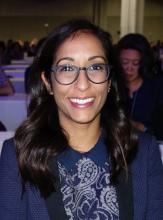To address the growing workforce shortage in rheumatology, medical educators will have to adapt and learn how to train a new generation of rheumatologists, according to a speaker at the 2023 Rheumatology Winter Clinical Symposium.
Anisha B. Dua, MD, an associate professor of rheumatology at Northwestern University, Chicago, told attendees she is “heavily invested in the training of our future rheumatologists” and strives to help them “operate at the top of the level across the spectrum.”
“They’re carrying forward our field,” Dr. Dua said. “We need to propagate our field and we need them to go out and serve and continue to make rheumatology awesome.”
The American College of Rheumatology’s 2015 workforce study estimates that by 2030, there will be a shortage of more than 4,000 rheumatologists in the United States.
Rheumatology may have inadvertently created the problem through rheumatologists diagnosing disease earlier and prescribing better treatments, with patients subsequently living longer with disease, she noted. Compounding the problem is an increasing number of rheumatologists looking to retire over the next decade and the continued need for care in rural areas where there are few practicing rheumatologists.
Interest in rheumatology is increasing
The good news is there is increasing interest in the field. “This has really shifted, I would say, from about 10 years ago when I was looking at fellowships,” Dr. Dua said. “It’s not really an interest problem. But the issue is that the training programs and slots don’t necessarily exist to fill the gap of the people who are leaving the field.”
The key to bringing more people into rheumatology is to understand how Millennials and Generation Z differ from generations that came before them. In general, members of Generation Z “tend to prefer an à la carte approach to education” with hands-on experiences, and they prefer customized feedback that is actionable, Dr. Dua explained.
“As a medical educator, there are different demands, and these are changing over time, so we have to figure out how we can best serve them and educate them,” she said.
This also means connecting with younger generations on social media. A research letter published in JAMA Network Open in 2021 found a minority of 650 physicians across 14 specialties had a presence on social media platforms, with 44.9% of physicians surveyed present on LinkedIn, 23.4% on Facebook, 18.6% of on Twitter, and 14.9% on ResearchGate. “There is a lot of room to grow, and this is where some of our future teaching is headed,” Dr. Dua said.
Future of rheumatology education
Does this mean rheumatologists should start dancing in TikTok videos? Maybe not, but Dr. Dua noted there are ways to bring understanding, recall, comprehension, and behavioral change through active learning, spaced learning, case-based modules, podcasts, videos, and other educational strategies.
“We need to find ways to engage our learners and connect with them and teach them,” she said.
Rheumatologists are already bringing innovation to the education space with initiatives like educational podcasts, remote learning developed during the COVID-19 pandemic, development of rheumatology Objective Structured Clinical Examinations using challenging patient scenarios, and other virtual learning opportunities. “We really have been forced to push the envelope,” Dr. Dua said.
“The future of medical education is here. It’s exciting. Embrace it,” she said.


